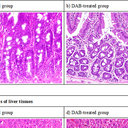Hypolipidemic effects of different angiocarp parts of Alpinia zerumbet.
Ключевые слова
абстрактный
BACKGROUND
In utilization of Alpinia zerumbet (Pers.) Burtt and Smith (Zingiberaceae) (AZ), usually the angiocarps are discarded without further use.
OBJECTIVE
We speculate whether the angiocarps could show hypolipidemic effect.
METHODS
Several diets were prepared: Alpinia seed powder (ASP); Alpinia seed powder/husk (ASH): 40/60; and Alpinia seed essential oil (ASO): 0.01-0.10%. Sprague-Dawley rats divided into 11 groups were fed these diets for 8 weeks and tested for the hypolipidemic bioactivity.
RESULTS
The fecal neutral cholesterol excretion was increased, and the serum total triglyceride (TG) was significantly reduced from 153.7 mg/dL in the high-fat group (H) to 114.3-119.8 mg/dL by ASO; to 116.3-147.9 mg/dL by ASP; and to 116.2-145.3 mg/dL by ASH. Activity of superoxide dismutase (SOD) and glutathione peroxidase (GPX) were almost unaffected. The high-density lipoprotein (HDL) levels were mostly raised by ASO to 180.3-200.8 mg/dL. The lowdensity lipoprotein (LDL) levels were mostly reduced to 66.8-82.6 mg/dL by ASH. The level of arachidonic acid was mostly raised to 0.50-0.60% by ASO, compared with 0.37% of group H. More importantly, the significant reduction in hepatic TG and total cholesterol (TC) implicated a crucial liver protective effect.
CONCLUSIONS
ASP and ASH consisted of high crude-fiber content, while ASO consisted of seed essential oil. Both the seed essential oil and the whole powder of AZ previously had been reported to possess potent hypolipidemic bioactivity. Conclusively, the hypolipidemic effect can be attributed to the combined effect of the essential oil and the crude fiber.


